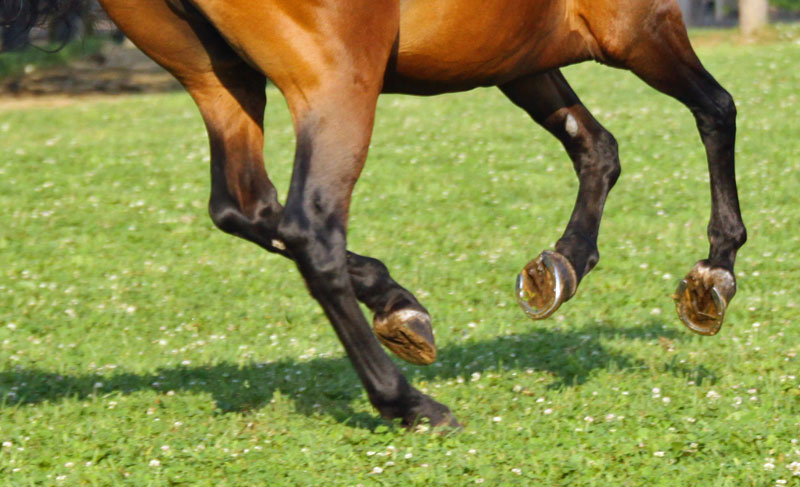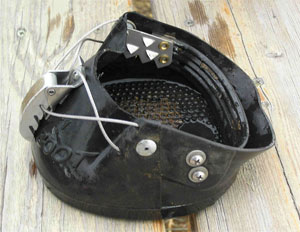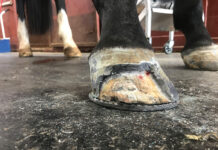
While barefoot is the most natural condition and is recommended whenever possible, horses often need the protection offered by shoes. In the last 15 years, alternative options to traditional metal shoes have exploded with choices that can offer advantages, depending on what your horse needs.
To learn more, we turned to Lana Haven of Ocala, Florida, who specializes in therapeutic, pathological, natural balance and performance shoeing, and trimming. A professional farrier for 35 years, she appreciates how the industry has changed over the years and the wide range of materials and options now available.
Haven says horses may be candidates for alternative hoofwear for a number of reasons. Some examples include a horse that typically goes barefoot, but is going for a long ride on rocky or hard footing; a horse that has foundered in the past and is sound now; or a horse that has poor quality feet that will not hold up for nailed-on shoes.

Hoof Boots
As the name implies, hoof boots are temporary hoofwear you put on and take off as needed. Made of durable synthetic material, boots come in a number of styles and manufacturers. To work well and be comfortable for the horse, they must fit properly.
Boots are useful for many applications, including long rides (many endurance riders swear by them), as well for therapeutic reasons, such as a foundered or sore-footed horse.
They attach in different ways. Some boots use a cable system. Others rely on hook-and-loop closure. Haven prefers the style that opens in the front of the hoof and has hook-and-loop closures that attach to the front tab, because this allows for adjustment to get a good fit.
“Proper fit is crucial,” says Haven. “You must make sure you’re on a good trimming schedule, anywhere from four to six weeks, so you don’t have issues with the boot not fitting right or rubbing the horse.
“You want to make sure they are broken in and the horse is used to them before going on a long ride,” she adds. “I recommend that clients ride in them a couple hours at a time, several times, before going on a long ride.”
Boots are one of the most economical shoeing alternatives because they can be used over and over.
Glue-On Shoes
With an ever-expanding variety on the market, glue-on shoes offer non-invasive protection and support. They come in three basic types: synthetic (polyurethane, polyethylene or acrylic polymers), aluminum core covered with polyurethane, and metal.
“Glue-on shoes are helpful for horses with soft feet that just don’t hold nails well, or when the hoof needs more protection and shock absorption,” says Haven. They are also commonly used to correct hoof disorders in foals, as well as adult horses, and when the hoof wall is badly damaged.
For glue-ons to work as designed, the farrier has to be well-versed in the process.
“When you glue on a shoe, the hoof and shoe surface have to be absolutely pristine, otherwise you will not get a good seal,” Haven notes, adding that they can last four to six weeks, when applied correctly.
Glue-on shoes require good hygiene and are considerably more expensive than traditional nail-on shoes.
Fiberglass Casts
This option uses fiberglass material that is impregnated with resins and polymers so it can be wrapped around the freshly-trimmed hoof and then sets up hard like a cast. Once the material hardens, it can be filed and rasped. It can also be applied over a shoe or a shoe can be placed over the fiberglass, if needed.
“Applied properly, you can do anything to it you would do to a regular hoof,” says Haven, who generally uses this option for therapeutic reasons, but does have a few owners using it as an alternative to metal shoes.
“It can last a few weeks or be left on until it wears or falls off, which is usually less than 6 weeks,” she says, “but I’ve had some horses pull it off with a hind foot if they are turned out 24/7.”
She explains that the fiberglass material is expensive and comes in widths of two to four inches. It costs more and typically does not last longer than having a horse shod with metal shoes.
Hoof Wraps
There are different varieties of flexible, non-cast wraps that simply wrap around the hoof and attach in different ways. Hoof wraps can be helpful when your horse is recovering from an abscess, sore feet due to thin soles, or as temporary protection when he’s lost a traditional shoe.
Some are designed like a bandage, while others wrap closely around the hoof to fit snugly and hold up for longer use.
Wraps, whether commercial or homemade, are good for temporary treatment of abscesses or injury to a hoof. When using a wrap in these situations, the horse is often on stall rest, which increases the likelihood of the wrap staying in place, protecting the hoof and keeping the wound clean.
Discuss with your farrier whether or not your horse is a good candidate for one of these alternative hoofwear options.
See all hoof care resources >>






Every horse owner, no matter discipline/breed, should read
“The Soul of a Horse” by Joe Camp. He also created Benji, and really understands animals. He went through a time of searching a questioning everything traditional about horses; shoes, stalls, blankets, etc. And he came up with some very fascinating answers. I won’t go into detail. Read the book yourself! It changed the way I look at horses now and I guarantee it will change your mind, too!
I understand and respect every one’s decision, but from reading this book, I made the decision that my horses will always go barefoot. They only wear blankets when it is unexceptionally low temperatures. I have also redesigned my future barn (in my mind). Instead of the traditional row of stalls (which is unnatural) my barn shall have large airy stalls only for shelter (and if they’re sick) and they will all open into a large paddock. My horses will have 24/7 turnout. Anyway, that’s my dream 🙂
read this book with an open mind and you will never look at a horse the same way again, I promise you!! :
Andrea, I 100% completely agree with you!! I, myself, have read, “The Soul of a Horse,” by Joe Camp. His book amazed me and I have 100% changed my mind about horses.
I’m glad that someone on HC agrees with me about this kind of stuff, as I really did think that I was the only one on HC that did 🙂
Oh, and Andrea: your dream (about the stable/pasture stuff)is the same as mine; no horseshoes or leg wraps (except bandages) for my horses. Just a warm, water proof, breathable blanket for when it is cold and rainy, bandages for injuries, and the same kind of 24/7 turnout you have; plus the stable as well 🙂
Good info
Some great options here. I’m especially interested in the fibreglass option for bad and mishapen hooves.
I’m pro barefoot for most horses but there are definite applications for shoes. E.g. horses that do a lot of work on pavement need shoes otherwise their feet wear down too quickly! That’s one of the main reasons shoes were invented.
MY Natl’Show Horse, Mystere’ has two different front feet. His right hoof is flatter than his left hoof. he wears shoes. The farrier and my vet believe he should wear shoes. I would like him to try him without shoes for a while. what do you think?
Lola
Another option is polyurethane Ground Control Horseshoes. They have been around for 14 years and are good for trail, jumping, buggy, all kinds of riding as well as for therapeutic purposes like founder, navicular and ring bone. They come in Black, clear and Hot pink and soon to be teal. They nail on, screw on or glue on.